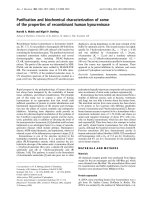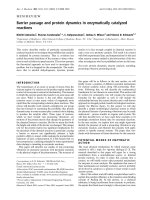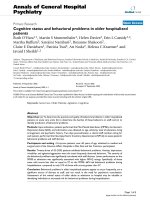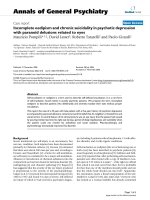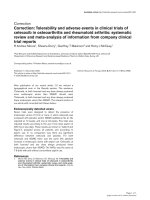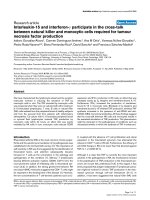Báo cáo y học: "Incomplete oedipism and chronic suicidality in psychotic depression with paranoid delusions related to eyes" pptx
Bạn đang xem bản rút gọn của tài liệu. Xem và tải ngay bản đầy đủ của tài liệu tại đây (202.21 KB, 4 trang )
BioMed Central
Page 1 of 4
(page number not for citation purposes)
Annals of General Psychiatry
Open Access
Case report
Incomplete oedipism and chronic suicidality in psychotic depression
with paranoid delusions related to eyes
Maurizio Pompili*
1,2
, David Lester
3
, Roberto Tatarelli
2
and Paolo Girardi
2
Address:
1
McLean Hospital – Harvard Medical School, Boston, MA, USA,
2
Department of Psychiatry – Sant'Andrea Hospital, University of Rome
"La Sapienza", Rome, Italy and
3
Center for the Study of Suicide, Blackwood, New Jersey, USA
Email: Maurizio Pompili* - ; David Lester - ;
Roberto Tatarelli - ; Paolo Girardi -
* Corresponding author
Abstract
Self-enucleation or oedipism is a term used to describe self-inflicted enucleation. It is a rare form
of self-mutilation, found mainly in acutely psychotic patients. We propose the term incomplete
oedipism to describe patients who deliberately and severely mutilate their eyes without proper
enucleation.
We report the case of a 32-year-old male patient with a five-year history of psychotic depression
accompanied by paranoid delusions centered around his belief that his neighbors criticized him and
stared at him. A central feature of his clinical picture was an eye injury that the patient had caused
by pouring molten lead into his right eye during a period of deep hopelessness and suicidality when
the patient could not resolve his anhedonia and social isolation. Pharmacotherapy and
psychotherapy dramatically improved his disorder.
Background
Severe intentional eye self-injury is an uncommon, but
not rare, condition. Such injuries have been documented
primarily in Christian cultures [1]. Favazza [1] estimated
that there were about 500 cases per year and, according to
Favazza and Rosenthal's [2] criteria for self-mutilation,
eye self-injury is considered to be a major self-mutilation.
Abrasion or introduction of chemical substances into the
conjunctival sac has been found in factitious disorder [3],
malingering [4], and character pathology [5]. Rogers [6]
has suggested that the severity of the eye injury produced
is proportional to the severity of the psychopathology.
Tapper et al. [7] reviewed the international literature from
1848 to 1957 and found 34 cases of severe, self-inflicted
eye injury of which 27 had received a psychiatric diagno-
sis, including 9 patients with schizophrenia, 13 with affec-
tive disorder, and 4 with organic conditions.
Self-enucleation or oedipism (the act of destroying one or
both eyes) has been described in psychotic patients [8],
most frequently in schizophrenics [9]. Feldman and Feld-
man [10] reported that, after performing self-enucleation,
patients were often found with a copy of Matthew's Gos-
pel open at 5:29 where it is states " if the right eye offend
thee, pluck it out and cast it from thee; for it is profitable
for thee that one of thy members should perish and not
that thy whole body should cast into hell". Apparently,
the enucleation enacts a literal interpretation of the text.
Matthew's Gospel (5:28) also states that "everyone who
has looked at a woman lustfully has already committed
Published: 21 November 2006
Annals of General Psychiatry 2006, 5:18 doi:10.1186/1744-859X-5-18
Received: 28 July 2006
Accepted: 21 November 2006
This article is available from: />© 2006 Pompili et al; licensee BioMed Central Ltd.
This is an Open Access article distributed under the terms of the Creative Commons Attribution License ( />),
which permits unrestricted use, distribution, and reproduction in any medium, provided the original work is properly cited.
Annals of General Psychiatry 2006, 5:18 />Page 2 of 4
(page number not for citation purposes)
adultery with her in his heart," thereby making the act of
looking a sin.
Cases of self-enucleation have also been described in
patients with drug-induced psychosis [11], bipolar disor-
der [7], obsessive compulsive disorder [12], post trau-
matic stress disorder [13] and depression [14]. According
to Moskovitz and Byrd [15] the following similarities are
found in self-enucleation patients: the act is viewed as a
means of saving themselves or the world; the patients do
not regret the action; they often quoted biblical passages;
and they were psychotic at the time of the act. MacLean
and Robertson [16] reviewed the literature and noted that
castration fears, failure to resolve oedipal conflicts,
repressed homosexual impulses, severe guilt, and severe
self-punishment were common psychodynamic features
of these cases.
We report a case here of a young man who attempted to
destroy his right eye. He had been suicidal for a number
of years, was diagnosed as having a psychotic depression,
had social phobia, somatic anxiety and compulsive obses-
sive traits, and showed perversion and delusions.
Case history
Mr. C, aged 32, poured molten lead into his right eye dur-
ing a period of great emotional distress and during a time
when pharmacological treatment for his depression was
not producing any beneficial effect. We call such an action
incomplete oedipism since the patient did not enucleate
the eye, but merely damaged it. After the injury, he was
hospitalized for a long period and, after much medical
treatment, had an almost normal eye. Destroying the eye
was, according to his words, a way of blackmailing his
parents. One evening, he had quarreled with his parents
who had denied him permission to buy a motorbike. As a
result, he decided to punish them by damaging his own
eye. This action took place after a long history of psychiat-
ric treatment, including prescription of a wide variety of
psychotropic drugs, ranging from neuroleptics to antide-
pressants, as well as atypical antipsychotics.
He had experienced at least three previous depressive epi-
sodes but no hypomania. His first depressive episode was
at the age of twenty. At time of our evaluation a DSM-IV
diagnosis of major depression was made comorbid with
DSM-IV-TR delusion disorder (persecutory type). One of
his main symptoms was a paranoid delusion that other
people, and in particular people living in his neighbor-
hood, stared at him all the time and laughed at him. This
belief made the patient angry and depressed since, as a
result, he felt unable to leave his home and, in addition,
he experienced great anxiety.
He grew up in a very disturbed family. His sister had a seri-
ous obsessive-compulsive disorder. His elderly parents
lacked empathy and showed hysterical and obsessive
behaviors. His relationship with his mother was very dis-
appointing for him as she was emotionally distant. She
would blackmail his father by pretending to faint and by
lying on the floor as if dead. The father rejected his son,
fearing that he could get infected by the patient. The father
said that he had not wanted him, and he ignored the son.
The patient had experienced a homosexual relationship
during his teens and showed some perversions involving
women. He used to meet prostitutes in the street, but only
to ask them if they offered the kind of sex for which he was
looking. He became excited thinking of sexual relation-
ships with very old ladies or performing bizarre sexual
acts, but he experienced guilt over these thoughts and
desires.
During our first meeting with the patient, he was anxious,
depressed and very insecure. He could not engage in any
social interaction and was afraid of other people's judg-
ment. He confessed that he engaged in deliberate self-
harm almost daily (such as cutting or inserting needles
under his skin) in order to reduce his deep anxiety, anger
and dysphoria. A central feature of this patient was his sui-
cidal intent as he always felt hopeless and depressed, una-
ble to have friends, a girlfriend or sustained social
interactions. He had never attempted suicide, but he had
a detailed plan for killing himself. He intended to jump
from a window if he experienced another serious depres-
sive episode. He had guilt delusions based on the large
amount of money spent for his eye treatments. He also
had hypochondriac delusions apparently based on mild
ailments which were later identified as side-effects of the
medications that he was taking.
Another feature of his personality was somatic anxiety.
His disorder distressed him in two totally different areas.
On one hand, he felt excited by his desires and thoughts;
on the other one hand he felt guilt over them and con-
demned them. This guilt led to anxiety and anger, result-
ing in deliberate self-harm and suicidality.
One of the authors (MP) treated him with regular sessions
of psychotherapy. At the beginning the patient was reluc-
tant to talk. He focused on his everyday difficulties, espe-
cially his belief of being stared by other people. After a few
months of psychotherapy, the patient revealed important
facts of his childhood life, especially related to his parents'
behavior. His mother was described as cold and lacking
feelings. The patient had experienced very strong hatred
for his parents for which he felt guilty. This severe guilt led
him to the eye injury. Contrary to expectations, the eye
self-injury in our patient was not related to any religious
Annals of General Psychiatry 2006, 5:18 />Page 3 of 4
(page number not for citation purposes)
belief. Psychotherapy also addressed his negative transfer-
ence feelings which were always covered with politeness
and compliance with the therapy.
At the time that he applied for a psychiatric consultation,
he felt hopeless and helpless but highly motivated to start
a new treatment. We prescribed quetiapine 800 mg a day,
lamotrigine 200 mg a day and lithium carbonate 600 mg
a day. We also gave him the chance to start psychody-
namic psychotherapy with one or two sessions per week
depending on factors such as his occasional request to
meet therapist twice a week, suicidal crises or serious epi-
sodes of hopelessness.
After eighteen months, the patient had dramatically
improved. Not only did he feel less depressed and more
positive about the future, but he was able to talk about the
eye injury without feeling guilty, recalling the stressful
period during which he had injured his eye. He was also
less suicidal, reporting thoughts of suicide only from time
to time.
Discussion
This patient had been seen by many psychiatrists, and
most of them had showed a reluctance to engage in a
sound patient-doctor relationship. He had, therefore, sim-
ply been prescribed different medications with no real
improvement. Several psychiatrists had prescribed heavy
doses of various psychotropic medication with no scien-
tific rationale.
Suicide risk was a major issue in this patient especially
during the boring and empty days when he was hopeless,
unable to leave his home and finding no reason to con-
tinue living.
According to his description, the injury to his right eye was
performed during one of these days in order to "change
things" and "to feel the pain in the body and not in the
mind." It was also during these moments that he wanted
to commit suicide. The therapeutic alliance was a key fea-
ture with this patient. Treatment was tailored to his needs.
Shneidman [17] conceptualized suicide as best under-
stood, not so much as a movement toward death, but as a
movement away from something which is always the
same: intolerable emotion, unendurable pain or unac-
ceptable anguish. If the level of suffering is reduced, the
individual will choose to live. Profound psychic pain is a
major part of the clinical picture of suicidal individuals, so
much so that self-harming thoughts and behaviors,
including self-mutilation, as well as suicidal ideation, ges-
tures and attempts, may become a way of attempting to
cope with this pain. The best way to prevent suicide is to
learn what is causing the distress, the tension and the
anguish.
Another key factor in this patient was the exclusion of
antidepressants. In fact, it became clear that the agitation,
insomnia, dysphoria and anger, as well as his suicidality,
during his periods of depression were made worse by the
antidepressants (both tricyclics and SSRIs) that he had
been prescribed. Recent reports suggested that caution is
imperative in prescribing antidepressants to people who
are at risk of suicide or to those people who are vulnerable
to develop suicidality as a result of antidepressant medica-
tions [18,19]. Nevertheless, generalizing about this risk is
incorrect given the results of a recent meta-analysis [20]
showing that antidepressants significantly reduce suicidal
behavior in the vast majority of patients and increase such
risk only in a very small vulnerable subpopulation. Also,
when treating depressed patients clinicians should bear in
mind the possibility of a misdiagnosed bipolar disorder.
Benazzi [21] pointed out that depressed patients are often
bipolar II patients, and he stressed the need to better dis-
tinguish between major depressive and bipolar disorders.
Antidepressants may have a negative effect on the course
of bipolar disorders, especially in the case of bipolar
depression which is generally worsened by such treat-
ment.
Patients who deliberately injure their eyes cause great dis-
tress to clinicians and often are avoided or treated phar-
macologically in order to minimize contact with them.
This feature is found also in the treatment of suicidal peo-
ple. Both disorders require clinical skills and an opportu-
nity for the patient to experience a solid patient-doctor
relationship.
Acknowledgements
The authors would like to thank John T. Maltsberger, M.D. for helpful clin-
ical consultation regarding this case.
References
1. Favazza AR: Bodies under siege: self-mutilation in culture and psychiatry
Baltimore, MD: John Hopkins University Press; 1987.
2. Favazza AR, Rosenthal RJ: Diagnostic issues in self-mutilation.
Hosp Community Psychiatry 1993, 44:134-140.
3. Rosenberg PN, Krohel GB, Webb RM, Hepler RS: Ocular Mun-
chausen's syndrome. Ophthalmology 1986, 93:1120-1123.
4. Wilson WA: Oedipism. Am J Ophthalmol 1955, 40:563-567.
5. Segal P, Mrzyglod S, Alichniewicz-czaplicka H, Dunin-horkawicz W,
Zwyrzykowski E: Self-inflicted eye injuries. Am J Ophthalmol 1963,
55:349-62.
6. Rogers T: Self-inflicted eye-injuries. Br J Psychiatry 1987,
151:691-693.
7. Tapper CM, Bland RC, Danyluk L: Self-inflicted eye injuries and
self-inflicted blindness. J Nerv Ment Dis 1979, 167:311-314.
8. Finkenbine R: Assaultive eye injury and enucleation. J Am Acad
Psychiatry Law 2000, 28:250-251.
9. Field HL, Waldfogel S: Severe ocular self-injury. Gen Hosp Psychi-
atry 1995, 17:224-227.
10. Feldman MD, Feldman JM: Stranger than fiction Washington, DC:
American Psychiatric Press; 1998.
11. Goldsmith W: Self-enucleation: Further views. Am J Psychiatry
1973, 130:329.
12. Stinnett JL, Hollender MH: Compulsive self-mutilation. J Nerv
Ment Dis 1970, 150:371-375.
Publish with BioMed Central and every
scientist can read your work free of charge
"BioMed Central will be the most significant development for
disseminating the results of biomedical research in our lifetime."
Sir Paul Nurse, Cancer Research UK
Your research papers will be:
available free of charge to the entire biomedical community
peer reviewed and published immediately upon acceptance
cited in PubMed and archived on PubMed Central
yours — you keep the copyright
Submit your manuscript here:
/>BioMedcentral
Annals of General Psychiatry 2006, 5:18 />Page 4 of 4
(page number not for citation purposes)
13. Leslie J, Taff ML, Patel I, Sternberg A, Fernando MM: Self-inflicted
ocular injuries: A rare form of self-mutilation. Am J Forensic
Med Pathol 1984, 5:83-88.
14. Aung T, Yap EY, Fam HB, Law NM: Oedipism. Aust N Z J Ophthalmol
1996, 24:153-157.
15. Moskovitz RA, Byrd T: Rescuing the angel within: PCP-related
self-enucleation. Psychosomatics 1983, 24:402-403.
16. Maclean G, Robertson BM: Self-enucleation and psychosis:
Report of two cases and discussion. Arch Gen Psychiatry 1976,
33:242-249.
17. Shneidman ES: Suicide as psychache. A clinical approach to self-destructive
behavior Northvale, NJ: Jason Aronson; 1993.
18. Baldessarini RJ, Pompili M, Tondo L, Tsapakis E, Soldani F, Faedda GL,
Hennen J: Antidepressants and suicidal behavior: Are we hurt-
ing or helping? Clin Neuropsychiatry 2005, 2:73-75.
19. Pompili M, Tondo L, Baldessarini RJ: Suicidal risk emerging during
antidepressant treatment: Recognition and intervention.
Clin Neuropsychiatry 2005, 2:66-72.
20. Baldessarini RJ, Pompili M, Tondo L: Suicidal risk in antidepres-
sant drug trials. Arch Gen Psychiatry 2006, 63:246-248.
21. Benazzi F: How could antidepressants worsen unipolar
depression? Psychother Psychosom 2003, 72:107-108.
